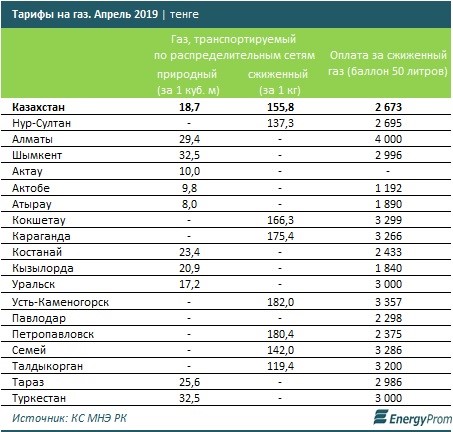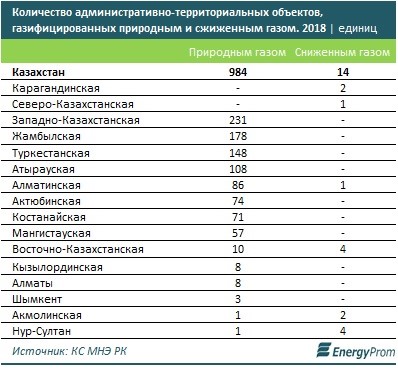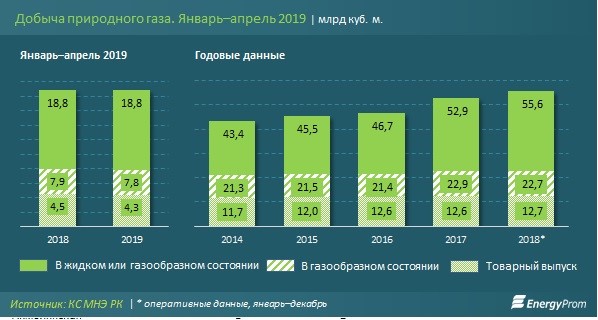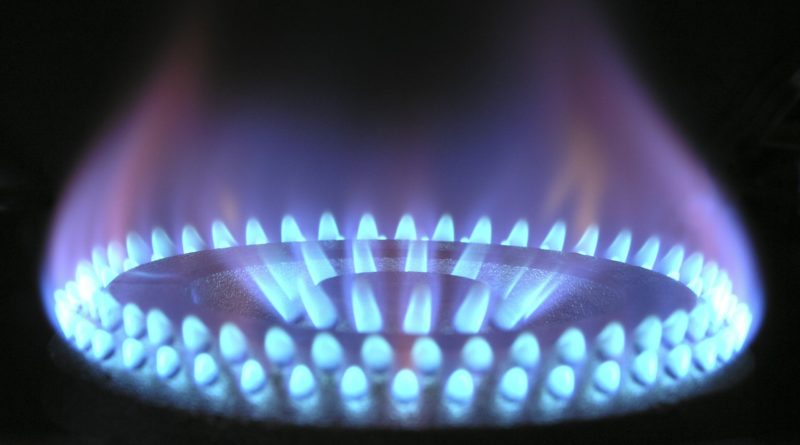Казахстанцы пользуются газом по цене ниже себестоимости.
За последние пять лет уровень газификации населения вырос с 30% до 50%
Число подключаемых к газу детских садов, школ, больниц и прочих объектов социальной и коммунальной сферы за пятилетку увеличилось на 86,5%
К маю текущего года тарифы на газ, поставляемый по распределительным сетям внутри РК для розничных потребителей, выросли незначительно; в сегменте природного газа рост составил 1,5% (до 18,7 тг за куб. м). В сегменте сжиженного газа отмечено незначительное сокращение: на 0,1% (до 155,8 тг за кг).
В то же время цена на сжиженный газ, поставляемый в баллонах, увеличилась на 2,1%, до 2673 тг за 50 литров.

Количество административно-территориальных объектов в РК, газифицированных природным газом, достигло 984 единиц, сниженным — 14. Самые высокие показатели по газификации природным газом ожидаемо отмечены в Западно-Казахстанской области: 231 объект. Среди лидеров также Жамбылская (178 пунктов) и Туркестанская (148 объектов) области.
Напомним, за последние пять лет возможность пользоваться газом получили более трёх миллионов казахстанцев, а уровень газификации населения вырос с 30% до 50%. Национальным оператором в сфере газотранспортировки и газоснабжения Казахстана является дочернее предприятие АО «НК „КазМунайГаз“» — АО «КазТрансГаз».
По данным АО «КазТрансГаз», на сегодняшний день в Казахстане возможность пользоваться голубым топливом имеют жители 11 областей страны. Если пять лет назад в республике насчитывалось 1056402 газифицированных абонентов, то к ноябрю 2018 года их количество увеличилось до 1777394, рост составил значительные 68%. Таким образом, по факту сегодня природным газом пользуются более 9 млн казахстанцев.
Также за последние пять лет выросло число газифицированных отечественных предприятий: с 23725 до 44189, или сразу на 86%. Из них крупных промышленных предприятий, по данным на 2013 год, было 1635, однако к ноябрю 2018 года показатель вырос на 82,8% и составил 2990 предприятий.
Растёт и число подключаемых к распределительным сетям детских садов, школ, больниц, различных объектов социальной и коммунальной сферы. По данным АО «КазТрансГаз», количество газифицированных коммунально-бытовых предприятий за пять лет выросло с 22090 до 41189, или на 86,5%.
Заметим: АО «КазТрансГаз» реализует газ на внутреннем рынке по цене ниже себестоимости, тем самым поддерживая отечественных потребителей. С 1 января снижены предельные оптовые цены на товарный газ — в пределах 17,5% в зависимости от региона. «Это позволило снизить конечные цены на электроэнергию и тепло практически во всех газифицированных регионах страны. В итоге на сегодняшний день газ, реализуемый на внутреннем рынке, продается ниже себестоимости, что является сдерживающим фактором для развития газовой отрасли. За период с 2014 по 2018 год национальный оператор в лице «КазТрансГаз» понёс убытки на внутреннем рынке около 200 миллиардов тенге. Это огромные цифры, о которых население должно знать», — сказал вице-министр энергетики Магзум Мирзагалиев в ходе круглого стола в Мажилисе Парламента РК. Он напомнил, что цены на газ для внутреннего рынка утверждаются ежегодно в правительстве.

Помимо газификации внутри страны, национальный оператор способствует росту значимости Казахстана и как поставщика собственного голубого топлива на мировые рынки, и как ключевого связующего звена на пути международного транзита. Так, к примеру, в текущем году АО «КазТрансГаз» возобновило транзит туркменского товарного газа через территорию РК в Российскую Федерацию по магистральному газопроводу «Средняя Азия — Центр».
Нацоператор смог начать транзит через свою систему газопроводов в рекордно короткие сроки: благодаря современным технологиям и модернизации магистрального газопровода «Средняя Азия — Центр» режим транспортировки туркменского газа был сформирован и запущен всего за несколько суток.
По данным компании, объём транспортировки туркменского газа в Российскую Федерацию по магистральному газопроводу «Средняя Азия — Центр» составляет 15 млн кубометров в сутки. С начала возобновления транзита через территорию Казахстана уже было транспортировано более 220 млн кубометров газа. Ранее транзит туркменского газа через газотранспортную систему Казахстана был прекращён в 2016 году. В начале 2019 года между Туркменистаном и РФ были достигнуты договорённости о возобновлении поставок газа в рамках действующего межправительственного соглашения о сотрудничестве в газовой сфере до 2028 года. Это позволило восстановить взаимовыгодное сотрудничество в газовой сфере сразу трём государствам.
Заметим, за последние годы казахстанская газовая отрасль прошла масштабную модернизацию, и, по оценке специалистов, компания «КазТрансГаз» стала важнейшим и технологически самым мощным оператором газовых потоков в Средней и Центральной Азии.

Напомним, добыча природного газа в жидком или газообразном состоянии за январь–апрель текущего года незначительно выросла в сравнении с аналогичным периодом прошлого года и составила 18,8 млрд куб. м, из них естественный газ в газообразном состоянии составил 7,8 млрд куб. м, товарный выпуск газа — 4,3 млрд куб. м.
41,9% добычи природного газа в жидком и газообразном состоянии традиционно пришлось на Атыраускую область (7,9 млрд куб. м, +1,3% за год), 36,7% — на ЗКО (6,9 млрд куб. м, −2% за год), 12,7% — на Актюбинскую область (2,4 млрд куб. м, +4,4% за год). При этом основная добыча природного газа в естественном состоянии (88,2% от РК) пришлась на ЗКО: 6,9 млрд куб. м (−0,7% за год).
Основным оператором добычи газа является материнская компания АО «КазТрансГаз», Национальная компания «КазМунайГаз». «КазМунайГаз» добывает 28% от общего объёма добычи нефти и газоконденсата и 16% природного и попутного газа в Казахстане, а также обеспечивает 95% транспортировки природного газа по магистральным газопроводам.
Источник: EnergyProm

